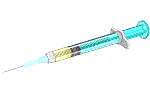

The following chart is included in a FDA Freedom of Information report issued
for Novartis Animal Health
US, Inc.'s "Program 6 Month Injectable" flea control for cats.
As you can see, cats in the study group receiving the "Program Injectable"
flea control product were eight times more likely to develop a post injection
lump or granuloma than those cats in the placebo group.
Adverse
Reactions: The following table compares the percentages of cats treated with
lufenuron injectable compared to the placebo (saline) control that exhibited
the following clinical observations.
Two
injection site lumps removed from cats treated with lufenuron showed changes
on histologic examination. In one cat the lump showed evidence of inflammation
surrounding an area of necrosis. There was marked proliferation of fibrous
connective tissue accompanying this reaction. In the other cat, the lump
showed granulomatous inflammation which included non-pleomorphic fibrocytes
and fibroplasia.
Below is a link
to the complete FDA report from which the information above was
obtained. This comprehensive report details the summary of research that
Novartis Animal
Health US, Inc. presented to the FDA for approval of its "Program
Injectable" flea control product.
"Link to the complete report"